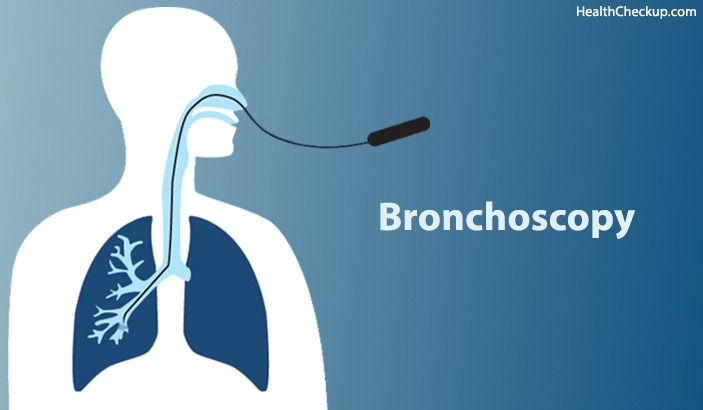Bronchoscopy is a medical test that allows the pulmonologist to examine your airways. A bronchoscope is a flexible fibre-optic instrument with a light and camera at the inserting end. The pulmonologist will recommend bronchoscopy when he notices some chest abnormalities in CT scan or X-ray. The bronchoscope is inserted through your nose or mouth to the lung to determine the internal structure of airways. The bronchoscope is of two types, Rigid or Flexible with real-time video device to detect airway obstruction. Generally, flexible bronchoscopy is used during the diagnosis and treatment. In a case like bleeding cough examination, rigid bronchoscopy is used with anaesthesia.
With a bronchoscope, the pulmonologist can view the respiratory system structure including larynx, trachea, and minor airways of lungs that consist of bronchi and bronchioles.
Bronchoscopy is used to Diagnose lung diseases, infection, bleeding, chronic cough and tumor. It can also be used to collect a sample of mucus or tissues, discard foreign object (like food particle) from the lung and evaluation of a possible lung infection.
Bronchoscopy Procedure:
You would be asked not to consume any food prior to 6 to 12 hours of the bronchoscopy. Blood-thinning drugs, aspirins and other medicines should be avoided too. A local anaesthesia spray with Lidocaine is applied to your nose to numb your throat during the procedure of bronchoscopy. A device called Pulse Oximeter may be put on a finger to check the oxygen in the blood content. Supplemented oxygen is provided if necessary.
The patient will be connected to a monitor for regular monitoring of heart rate, blood pressure and oxygen level in blood. The bronchoscope is inserted through the nose or mouth of the patient. As the bronchoscope enters the airway, an additional topical anaesthetic is used to reduce the discomfort and cough spells. The rigid bronchoscope is inserted through the mouth only after general anaesthesia. The flexible type of bronchoscopy rarely causes any discomfort or pain. Major reason is that the flexible bronchoscope is tubeless.
Rigid Bronchoscopy
Rigid bronchoscopy is used majorly in the cases of bleeding cough. It is because the rigid bronchoscope has a large suction tube and can utilize the equipment that can control bleeding.
The camera at the inserting end of bronchoscope will detect and evaluate the internal structure of the lungs and airway. The Surgeon may provide a saline solution through the tube to wash the lungs. The Surgeon may collect some samples depending on the condition for further examination. It is a painless procedure.
In the case of airway blockage, the surgeon may place a stent in your airway. Sometimes Ultrasound is used to see the lymph nodes and tissues around your airways.
Bronchoscopy outpatient procedure takes less than an hour. You would be put at rest in the hospital as you were given sedatives. Your breathing and blood pressure will be monitored after the procedure. You can’t eat or drink till your throat is no longer numb. This doesn’t take more than two hours.
Bronchoscopy Complications:
Risks of Bronchoscopy are Minimal.
- Your nose and throat may be a little sore for a day. Because of sedatives, you may feel sleepy and drowsy for several hours. Bronchoscopy cases have very rare risks of severe damages.
- Fever is common after the biopsy but doesn’t cause any infection.
- In rare cases following the bronchoscopy, a throat or chest infection may develop.
- There are slight chances of bleeding if the airways are inflamed or damaged by a disease or if a biopsy was taken.
- If the lung is punctured during rigid bronchoscopy, then there are chances of one or both the lungs to collapse. It is called Pneumothorax and is life threatening.
- If the air accumulates around your chest during the procedure, then the doctor may extract it from a chest tube.
Patients vary in their anatomical framework. So rare patients may develop complications related to vocal cord injury, irregular heartbeats, change in blood pressure, heart attack because of lack of oxygen in the blood tissue, etc. Rare cases have teeth damage during rigid bronchoscopy.
Medically Reviewed By









